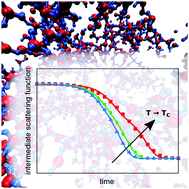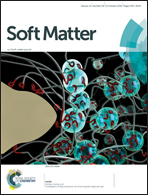Two time scales for self and collective diffusion near the critical point in a simple patchy model for proteins with floating bonds†
Abstract
Using dynamic Monte Carlo and Brownian dynamics, we investigate a floating bond model in which particles can bind through mobile bonds. The maximum number of bonds (here fixed to 4) can be tuned by appropriately choosing the repulsive, nonadditive interactions among bonds and particles. We compute the static and dynamic structure factor (intermediate scattering function) in the vicinity of the gas–liquid critical point. The static structure exhibits a weak tetrahedral network character. The intermediate scattering function shows a temporal decay deviating from a single exponential, which can be described by a double exponential decay where the two time scales differ approximately by one order of magnitude. This time scale separation is robust over a range of wave numbers. The analysis of clusters in real space indicates the formation of noncompact clusters and shows a considerable stretch in the instantaneous size distribution when approaching the critical point. The average time evolution of the largest subcluster of given initial clusters with 10 or more particles also shows a double exponential decay. The observation of two time scales in the intermediate scattering function at low packing fractions is consistent with similar findings in globular protein solutions with trivalent metal ions that act as bonds between proteins.

- This article is part of the themed collection: Electrostatics and Soft Matter


 Please wait while we load your content...
Please wait while we load your content...